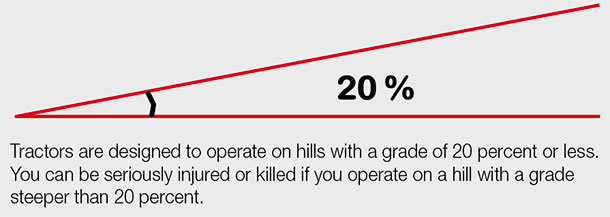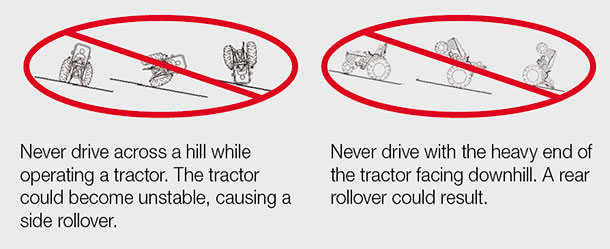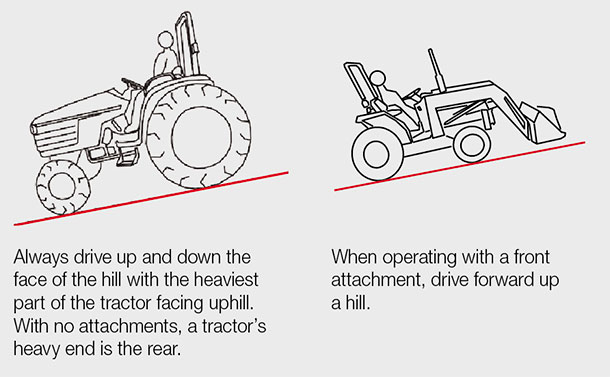Tractor injuries typically fall in one of four categories: rollovers, runovers, entanglements or collisions. Every person on your farm operating a vehicle (farm truck, tractor, ATV, etc.) should be familiar with its user manual and basic safety for a safe and productive season.
All safety mechanisms should be engaged while in operation. Remind yourself and your helpers not to cut corners. The speedy way is often the dangerous way, so take your time. Inspect your machinery before using it. Wear adequate restraints and personal protective equipment, and always be aware of your surroundings. Your safety is worth the time and effort to be cautious.
Operating on slopes
The typical tractor is not designed for working on intense slopes. A 20 percent slope is the steepest grade most can handle. Use tractors with wide-set tires on the front and back. Intense slopes require specialized equipment and trained operators.

Do not put yourself at risk by operating on slopes too steep for your machinery. These types of slopes are better cared for with hand-operated equipment or managed as conservation areas for wildlife. Use walk-behind cultivators and mowers, weed eaters, backpack sprayers and hand-crank broadcast seeders for these areas.
Machinery designed for slopes typically has attachments on the front end rather than the rear and dual, tri or even quad tires to increase stability. Few dealers carry this type of equipment on the borders of the Corn Belt, but they do exist. There are some incredible machines designed in Switzerland and Australia for working on slopes.
Do not disengage rollover protective structures, and always wear your seat belt. Since rollover protective structures were not standard until the mid-’80s, millions of tractors in rural America are not appropriately equipped to protect the rider in the event of a rollover.
 Retrofitted rollover protective structures can be obtained from tractor dealerships for older tractors. The combination of a rollover protective structure and seat belt are 99 percent effective in preventing rollover fatalities.
Retrofitted rollover protective structures can be obtained from tractor dealerships for older tractors. The combination of a rollover protective structure and seat belt are 99 percent effective in preventing rollover fatalities.
If you determine your slopes are workable, follow these tips for safe operation:
- Go slow. Never go down a slope faster than you would climb it.
- Keep your movement smooth. Jerky stops, starts and turns decrease stability.
- Always keep the heavy end uphill. If your attachment is on the rear of the tractor, always keep it uphill. If you are carrying a load on the front of your tractor, keep the load low to the ground and uphill.
- Distribute loads on attachments evenly. Take care to prevent them from shifting in transit.
- Do not drive laterally across slopes. Driving across slopes shifts your center of gravity and is the leading cause of side rollovers.
- Do not climb slopes if your load or attachment is in the rear. This is one of the leading causes of rear rollovers. If you are unable to approach the slope from top to bottom, back up the slope, keeping the heavy end uphill.
- Back out if the tractor gets stuck in mud. Do not pull forward. If you cannot free the tractor by backing out, it should be towed out.
- Be additionally cautious on wet or partially frozen ground. Areas that were stable during dry conditions may not be anymore. During freeze and thaw cycles, the soil will heave and swell or compress. Be sure to change your approach to cope with the conditions.

Working safely on slopes is all about keeping your center of gravity on target. Use included figures as visual representations of appropriate and inappropriate practices (used with permission from Kansas State University Extension).
Tillage and seeding
Depending on the type of forage you intend to plant, you may or may not need to till the soil for establishment. If tillage is necessary, wait for the weather to cooperate. Soil needs to be thawed and firm enough to walk on without leaving depressions. Often plantings that require tillage are best saved for late spring or early fall. If you use a small tiller that can be pulled by an ATV or a walk-behind model, you will have more flexibility in spring conditions.
No-till drills are excellent for interseeding into existing vegetation. Again, small attachments are often most appropriate for sloped areas. Prevent shifting in the seed box while working on slopes by adding dividers between the feed cups.
Hand-crank broadcast seeders work well for slopes. They are easy to use and versatile. Try these for frost-seeding clovers into grass pastures and cultivated seed beds.
Packing or raking the seed bed is sometimes recommended after seeding. If your slope is too steep to do this with machinery, use hand tools instead.
Soil erosion needs to be minimized when tilling and planting on slopes. After seeding, add a permeable cover to the soil surface, like straw or landscape netting (erosion blankets) to prevent soil and seed wash-off in a rain event.
Wait to apply fertilizer until the plants are actively growing. Otherwise, weeds will utilize the fertilizer instead of your forage, or it will be carried away by the elements. Keep animals off of the establishment site until the plants have developed thick roots and leaves.
Renovating high-traffic areas
The agile feet of grazing animals have the ability to wear down forage in high-traffic areas. Since they are creatures of habit, they will continue to use the same trails to travel up and down the slopes. Once the forage cover is worn away, soil wears away too. These worn areas need to be renovated on occasion to prevent erosion and the formation of gullies.
Of course, soil compaction is an issue in these areas. If possible, designate these paths as lanes to travel on for both livestock and machinery rather than attempting to turn compacted and worn areas back into grazable pasture. Reinforce the lane with geotextile fabric and gravel. Remember to choose gravel that is the appropriate size for livestock to walk on comfortably.
Summary
Sloped pastures pose unique challenges for farm managers and are an integral part of production for many. Always put safety first. Take precautions to prevent erosion, seed and fertilizer loss. Remember: A tractor may not be the best tool to use when establishing forages on slopes. ![]()
PHOTO: Every person on your farm operating a vehicle (farm truck, tractor, ATV, etc.) should be familiar with its user manual and basic safety for a safe and productive season. Photo by Getty Images.

-
Christine Gelley
- Extension Educator Agriculture and Natural Resources – Noble County Extension
- Ohio State University
- Email Christine Gelley











